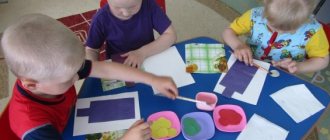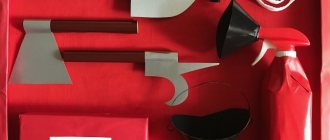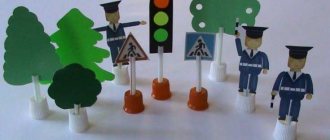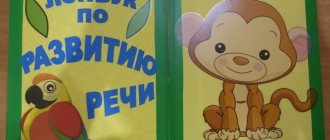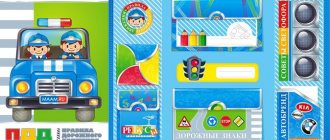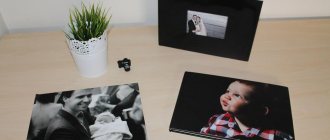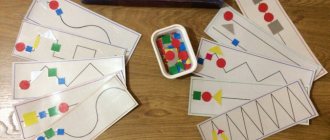What teaching aids can you make yourself for kindergarten?
Language development is not an isolated skill. To a large extent, it is determined by the general level of development of the child and, in particular, his intelligence.
Didactic manual on speech development
Activities that improve sensory and fine motor skills in children are of great importance in this process. For this, it is important to use teaching aids, a significant part of which can be made independently.
Children's learning, especially in junior and middle groups, should take place in a playful environment, otherwise they will lose interest in the subject and time will be wasted. For teaching to be effective, the teacher needs to use all available means to maintain the child’s useful activity.
Didactic materials for sensory development
The “Flower Petals” manual looks like this. A circle is attached perpendicularly to the straight stem. The edges of the central part are covered with Velcro. Several petals with images of objects or fairy-tale characters are offered. This fabric is also attached to the inner edge of each of them. The task is to find the petals with the corresponding words based on the letter drawn on the mug and attach them to the central part.
The game “Blow out the insects into the clearing” is designed to develop speech breathing. For this purpose, the “Polyanka” manual is used. It is a low box with high sides. Small cardboards with images of animals are suspended on short threads from the outside. The child must blow them out, but does not have the right to puff out his cheeks.
Important! In this way he is taught how to breathe correctly during a conversation.
The game "Clothespins" is made using the same manual. For this, the kids are given several colored clothespins and asked to build a fence. They place them on the edges, while loudly calling out the color used.
There are two horizontal lines of Velcro glued to the outer wall of the Polyanka manual. Each row contains four cards with images of animals, fairy-tale characters or objects. The child is told that in each row one of the pictures is extra and is asked to remove it. Then he should tell what the remaining images have in common and why.
Lesson with children
Iconic didactic materials
One of these multifunctional aids is “Teremok”. It is a fabric house attached to a flat, solid base. It has a large number of pockets sewn into it, in which various pictures are placed. They can depict objects of the surrounding world, fairy-tale characters from the fairy tale of the same name, images of letters or syllables.
Modern methods and games for teaching speech for non-speaking children
There are various ways to use this manual in kindergarten.
Here's one of them. Children are shown pictures taken from a pocket attached to the tower. They ask what fairy tale this hero, who is depicted on the card, came from. The child must remember the name of the fairy tale and try to retell its content.
Important! If the child needs the help of a speech therapist, then it is provided. During the story, the teacher asks the child simple leading questions.
You can also use this manual in a preschool educational institution as follows:
- The teacher takes out cards showing the inhabitants of the tower, but does not show them. He depicts the sounds these animals make. The child must repeat them and name the hero of the fairy tale who is depicted on the card.
- The manual can be used to study prepositions that show the relative position of cards. The teacher places cards with pictures of animals in various pockets and asks questions about who is located where. The child must answer using the prepositions “above,” “under,” or “between.”
- Then the child is asked to formulate questions using the mentioned prepositions and ask them to the teacher.
Another task is the following:
- The child is given cards with images of fairy tale characters and asked to place them in various pockets.
- After this, the kid must say which animal lives on which floor and who is to the left, right, above or below him.
“Speech therapy ABC” (Ozone)
I don’t particularly like the pictures in this book (animals are tolerable, but people are a disaster!), but for some reason I often have to compromise with the manuals.
In general, it looks like this. For each letter (although it is probably more appropriate to talk about sounds here) there is a turn. On the left page in the upper corner the letter is always clearly written, in the center there are 2 poems for practicing sound. One is long, the other is short. Below is another short story/task, along the edge are pictures of objects that contain sound. Moreover, not necessarily in first place. Well, in general, as here - scarf, phone.
The most important plus is the poems with consonants, where the lines alternate: one with syllables, one just poetic. Looks like that:
Vlad simply adores all these ba-be-bi-bo-bu-by-ba, he repeats it enthusiastically, but it seems to me that he doesn’t pay attention to the lines “with meaning”, they are needed purely for a break))) In general, the poems are quite crazy , but the benefits cannot be taken away from them!
With vowels, everything is not so fun, and in general, consonants are the most popular in this book. But nevertheless, the structure of the reversal is the same.
Now the passions have already subsided, but about six months ago or a year (I don’t remember exactly when I bought it), it was just a hit!
And a bonus!!! A funny incident from life! Allow me to share, do not refuse the courtesy. When I first bought the book, I showed it to my husband, and his gaze fell on the author’s full name - b. Lagzdyn. lagzdyn?? - he asks in surprise. And I think that he wants to laugh at his last name, but which of us will undertake to judge him? But he continues without pause: Gayda? Reingoldovna? Lagzdyn?? At first it seems to me that he is joking, that he is inventing an ornate name from initials to match his surname, but I immediately understand that it is too fast and smooth! And now he’s still holding a dramatic pause, and I’m getting really scared (what do I even know about the person sitting opposite me? What other secrets does he keep??)
In general, in the end it turned out that this is our famous Tver poetess, so from time to time her name comes up in connection with some meeting with readers.
Okay, let's get back to the books))
Where are teaching materials used?
The use of hand-made speech development aids for preschoolers creates a playful basis for working with them and determines the storyline of the lesson. A child, especially in the junior and middle groups of kindergarten, thinks concretely, using images, rather than abstract logical constructs. He can react to assignments received from a speech therapist or teacher, being a participant in a specific, albeit fictitious, situation. The teaching aids serve as the factual basis for their learning each year.
Speech development based on visual cues
When a child learns to express his thoughts, he must follow a certain pattern of expressing his thoughts. For a child who is almost unable to concentrate on one subject at his age, this is impossible. Using teaching aids in the form of cue cards helps build a story line. For younger children, we are talking about much simpler things. They simply have to name the objects or briefly describe the actions with the cue cards.
Speech therapist works with a child
For example, in the didactic manual “Zippers,” the child must choose among the open colored zippers lying on the table those that correspond to the teacher’s instructions and close them. At the same time, the child describes his choice, its reasons and the actions he takes.
At an older age, each visual cue can be used together with leading questions from the teacher and be the basis for a coherent story. This can be seen, for example, in classes devoted to professions.
An interesting activity in the middle group on speech development
Every description of your actions, answer to a specific question, or short story based on visual cues helps your child better develop his speech skills. Serve as preparatory exercises for adult life.
Learning to retell
The development of coherent speech in children is one of the most important skills that a child must be taught. Without mastering it, he will not only not be able to develop properly intellectually, but also will not be able to fully socialize, not being able to conduct a dialogue or express his thoughts.
When retelling, the child must create a coherent, long story. However, for this he will need tips, which can be received during didactic games and from the teacher.
The development of fine motor skills plays an important role in this process.
Important! By engaging in retelling, you will be able to strengthen your speech and intellectual skills and increase the level of development of your personality.
Learning to think
Human speech is closely related to thinking. The same is true for a child. Communication is not limited to expressing your thoughts or describing actions. The level of speech proficiency is largely determined by the degree of development of the child’s personality and thinking.
Do-it-yourself teaching aids for kindergarten can be used not only for stories, but also as an excuse to ask your child questions about cause-and-effect relationships in the world around him. For example, using cards related to the plots of fairy tales, you can ask questions about the circumstances of the characters’ actions, the reasons and consequences of their actions.
You can combine the classes in question with the study of mathematics.
In addition, the educational function of speech development classes is important. For example, if a child is asked questions about the features and beneficial properties of the plants depicted in the pictures, then gradually this knowledge will be consolidated in the child. If additional questions are asked about this material, the child’s knowledge will become more detailed and practical.
Preparing for literacy
To do this, you need to learn not only oral speech, but also study letters and words. Children of senior preschool age, with the help of a teacher and parents, are able to master the alphabet and basic reading skills.
For this purpose, a do-it-yourself didactic manual on speech development for kindergarten with cards depicting letters, syllables or words can be used.
Picture 4 Speech corner
“Try again!” (Ozone // Labyrinth)
This book is an oasis in the world of manuals, in which, as I mentioned above, usually, if everything is good with the meaning, then everything is bad with the design.
Everything is great here. Each page has 2 lines - either a whole tongue twister, or part of it, the pictures are nice.
Tongue twisters of varying complexity, of course, three-year-old Vlad is far from capable of everything, and we don’t particularly strive for speed.
I like the clear, large print, always on a white background - the book is also suitable for children who read independently.
The importance of didactic material in kindergarten
Didactic manuals serve as the basis for speech development classes. They create a storyline for the lesson, involving children in the game plot. This takes into account the concreteness and figurativeness of children's thinking. With their help, a fascinating game situation is created for the child to learn, where he is passionate and motivated to complete tasks.
The development of children's speech relies heavily on various didactic aids. Their diversity and the ability to make most of them with your own hands allows you to choose a suitable option for conducting classes with children.
Articulation gymnastics for boys (Ozone // Labyrinth)
I already wrote about this book in a review about books with typewriters, and it is still popular among us. I repeat.
The design is also very sad, although Vlad likes it. On the plus side, the main articulation exercises are tailored to the story about the car, so it’s interesting for a boy to do all this (there is a similar one for girls, and there is also a book with breathing exercises).
If I don’t like the pictures, then the format of the book itself, in my opinion, is ideal. Usually in such publications there are several exercises on 1 sheet (or you have to use cards), this is inconvenient, the child is distracted by others, by the next spread.
And this book is on a paper clip. This means you can wrap it up so that only the exercise you are working on is visible. There is only 1 on each page.
When we first bought it, I didn’t know what to do with it. Vlad constantly pestered her and forced her to do exercises. Now it’s somehow easier because I found a secluded place for a hiding place, I take it out purely for exercise. But, by the way, he memorized the exercises, and sometimes he finds it himself, sits and does it, alone.
“Album on speech development” (Ozone // Labyrinth)
This is the older brother of the previous album, it is not so wildly popular among us, but it is also very good. Suitable for children 3-6 years old.
More complex concepts are already being considered here, not the moo cow, but geometric shapes, seasons, prepositions and cases. Well, the child, of course, does not have to say that this is such and such a case, there are simply a number of exercises that help to form correct speech. And they are grouped according to one principle or another (case, preposition, verbs, etc.)
In general, there are a lot of useful tasks there, and I plan to return to it, because... Now Vlad is better able to hold his attention, but we abandoned it precisely because there are a lot of pictures on one sheet of paper, and when I tell him about one, he looks at another.
Another big minus for me is that all the pictures are made in a different style. If in the album for the little ones they are, although not the most beautiful, but at least uniform, then here some go to the forest, some for firewood. Either cartoonish or realistic, even on 1 sheet. I really don't like this mess! But in general, there is no outright crime, sparkles, tacky frames and generally the style of “Hey, hey! This is for children! , so you can live.
In general, I can’t say that the album is ideal, I bought it rather out of inertia, on the wave of the popularity of the previous one, but overall I’m happy with this manual, if we consider the number of tasks and their wording, the mass, mass of all kinds of exercises! Moreover, you can, after all, look at the principle of working out, and practice not directly from the album, but, say, with toys. Well, the price is very reasonable.
